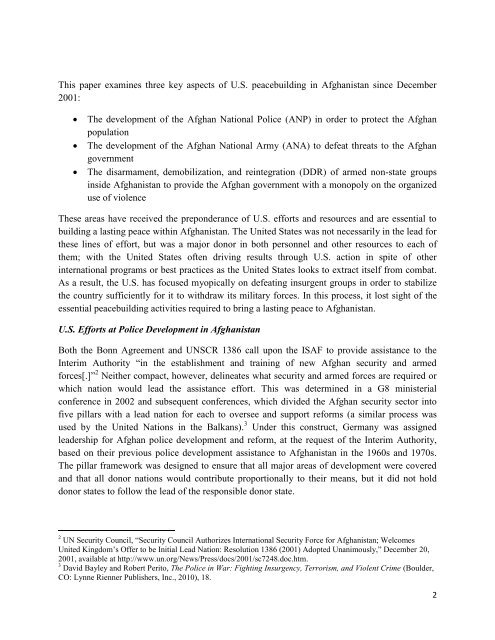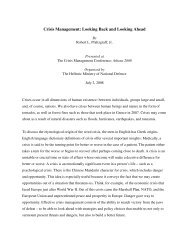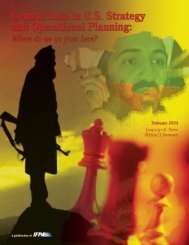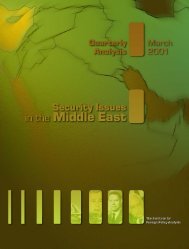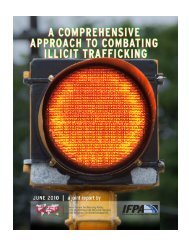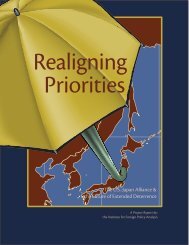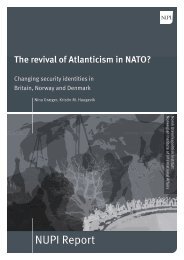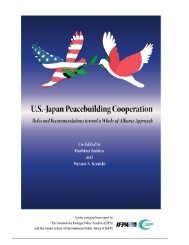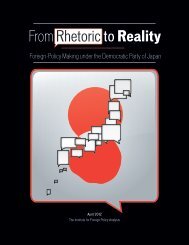This paper exam<strong>in</strong>es three key aspects of U.S. peacebuild<strong>in</strong>g <strong>in</strong> <strong>Afghanistan</strong> s<strong>in</strong>ce December2001:The development of the Afghan National Police (ANP) <strong>in</strong> order to protect the AfghanpopulationThe development of the Afghan National Army (ANA) to defeat threats to the AfghangovernmentThe disarmament, demobilization, and re<strong>in</strong>tegration (DDR) of armed non-state groups<strong>in</strong>side <strong>Afghanistan</strong> to provide the Afghan government with a monopoly on the organizeduse of violenceThese areas have received the preponderance of U.S. ef<strong>for</strong>ts and resources and are essential tobuild<strong>in</strong>g a last<strong>in</strong>g peace with<strong>in</strong> <strong>Afghanistan</strong>. The United States was not necessarily <strong>in</strong> the lead <strong>for</strong>these l<strong>in</strong>es of ef<strong>for</strong>t, but was a major donor <strong>in</strong> both personnel and other resources to each ofthem; with the United States often driv<strong>in</strong>g results through U.S. action <strong>in</strong> spite of other<strong>in</strong>ternational programs or best practices as the United States looks to extract itself from combat.As a result, the U.S. has focused myopically on defeat<strong>in</strong>g <strong>in</strong>surgent groups <strong>in</strong> order to stabilizethe country sufficiently <strong>for</strong> it to withdraw its military <strong>for</strong>ces. In this process, it lost sight of theessential peacebuild<strong>in</strong>g activities required to br<strong>in</strong>g a last<strong>in</strong>g peace to <strong>Afghanistan</strong>.U.S. Ef<strong>for</strong>ts at Police Development <strong>in</strong> <strong>Afghanistan</strong>Both the Bonn Agreement and UNSCR 1386 call upon the ISAF to provide assistance to theInterim Authority “<strong>in</strong> the establishment and tra<strong>in</strong><strong>in</strong>g of new Afghan security and armed<strong>for</strong>ces[.]” 2 Neither compact, however, del<strong>in</strong>eates what security and armed <strong>for</strong>ces are required orwhich nation would lead the assistance ef<strong>for</strong>t. This was determ<strong>in</strong>ed <strong>in</strong> a G8 m<strong>in</strong>isterialconference <strong>in</strong> 2002 and subsequent conferences, which divided the Afghan security sector <strong>in</strong>tofive pillars with a lead nation <strong>for</strong> each to oversee and support re<strong>for</strong>ms (a similar process wasused by the United Nations <strong>in</strong> the Balkans). 3 Under this construct, Germany was assignedleadership <strong>for</strong> Afghan police development and re<strong>for</strong>m, at the request of the Interim Authority,based on their previous police development assistance to <strong>Afghanistan</strong> <strong>in</strong> the 1960s and 1970s.The pillar framework was designed to ensure that all major areas of development were coveredand that all donor nations would contribute proportionally to their means, but it did not holddonor states to follow the lead of the responsible donor state.2 UN Security Council, “Security Council Authorizes International Security Force <strong>for</strong> <strong>Afghanistan</strong>; WelcomesUnited K<strong>in</strong>gdom’s Offer to be Initial Lead Nation: Resolution 1386 (2001) Adopted Unanimously,” December 20,2001, available at http://www.un.org/News/Press/docs/2001/sc7248.doc.htm.3 David Bayley and Robert Perito, The Police <strong>in</strong> War: Fight<strong>in</strong>g Insurgency, Terrorism, and Violent Crime (Boulder,CO: Lynne Rienner Publishers, Inc., 2010), 18.2
The G8 plan <strong>for</strong> police development was to raise a professional national police <strong>for</strong>ce of 62,000officers by December 2005, consist<strong>in</strong>g of 44,300 uni<strong>for</strong>med police, 12,000 border police, 3,400highway police, and 2,300 counter-narcotics police. 4 It was based on a European tra<strong>in</strong><strong>in</strong>g modelof police development, which <strong>in</strong>cluded “university level education <strong>for</strong> officers and a shorteracademic program <strong>for</strong> [non-commissioned officers, or NCOs]” 5 In a country with a male literacyrate under 50 percent and no stand<strong>in</strong>g police <strong>for</strong>ce from which to draw, this police developmentprogram with a target <strong>for</strong>ce of that size would have likely taken decades to complete. That sort oftime horizon was unacceptable to the United States, prompt<strong>in</strong>g it to create a parallel, but notnecessarily complementary, police development program. The United States gave theDepartment of State’s (DoS) Bureau of International Narcotics and Law En<strong>for</strong>cement Affairs(INL) the lead on establish<strong>in</strong>g seven regional police tra<strong>in</strong><strong>in</strong>g centers throughout <strong>Afghanistan</strong>.As INL is staffed by <strong>Foreign</strong> Service Officers and not law en<strong>for</strong>cement officials, it must drawupon outside expertise when undertak<strong>in</strong>g police development missions. 6 For larger operations,such as its <strong>in</strong>itial development ef<strong>for</strong>ts <strong>in</strong> <strong>Afghanistan</strong>, INL must rely upon contractors to executethe bulk of its operations, usually the contract<strong>in</strong>g firm DynCorp, because of both the lack of anational U.S. police <strong>for</strong>ce to draw upon and also its lack of <strong>in</strong>-house police expertise. INL is alsoa primary funder of the U.S. Department of Justice’s International Crim<strong>in</strong>al InvestigativeTra<strong>in</strong><strong>in</strong>g Assistance Program (ICITAP), an organization whose primary mission is to conductpolice development operations as part of U.S. <strong>for</strong>eign policy. While ICITAP would have beenthe likely U.S. government agency to provide the U.S. cont<strong>in</strong>gent <strong>for</strong> Afghan policedevelopment, they were not selected to do so. The result of INL’s ef<strong>for</strong>ts was essentially a policetra<strong>in</strong> and equip program, not a police development program, and it was executed almost entirelyby contractors with m<strong>in</strong>imal government oversight.INL’s tra<strong>in</strong><strong>in</strong>g program consisted of an eight-week basic polic<strong>in</strong>g course <strong>for</strong> literate NCOs andpatrolmen, a five-week course <strong>for</strong> illiterate patrolmen, a fifteen-day refresher course <strong>for</strong>experienced police officers, and a two-to-four-week course <strong>for</strong> police <strong>in</strong>structors. 7 This created asemi-tra<strong>in</strong>ed Afghan National Police (ANP) <strong>for</strong>ce of over 70,000 personnel by 2007. Thetra<strong>in</strong><strong>in</strong>g program was quite austere, with tra<strong>in</strong>ees <strong>in</strong> day-long classes on hard benches <strong>in</strong>classrooms with no temperature control. Instruction was given by contractors with littleexperience <strong>in</strong> police development and who did not speak the native languages and so dependedupon <strong>in</strong>terpreters with little grasp of polic<strong>in</strong>g term<strong>in</strong>ology. 8 More than 70 percent of the recruitswere illiterate, which challenged further their ability to absorb and comprehend the curriculum.4 Inspectors General, <strong>US</strong> Department of State and <strong>US</strong> Department of Defense, “Interagency Assessment of<strong>Afghanistan</strong> Police Tra<strong>in</strong><strong>in</strong>g and Read<strong>in</strong>ess,” November 2006,http://oig.state.gov/documents/organization/76103.pdf, 5.5 Bayley and Perito, 20.6 William J. Durch and Madel<strong>in</strong>e L. England, “International Police: Improv<strong>in</strong>g Professionalism andResponsiveness,” Stimson Center, Stimson Future of Peace Operations, September 2009,http://www.stimson.org/images/uploads/research-pdfs/Police_Issue_Brief.pdf, 6.7 Bayley and Perito, 21.8 Ibid.3


